The MEMS probes market is estimated at USD 269.6 million in 2025 and forecasted to reach USD 592.8 million by 2035, advancing at a CAGR of 8.2%. A 10-year growth comparison highlights how expansion has accelerated over time. From 2020 to 2025, the market rises from USD 181.8 million to USD 269.6 million, generating an absolute gain of USD 87.8 million. This early phase reflects gradual adoption, largely supported by demand in semiconductor testing, miniaturized device validation, and precision sensing applications, forming the foundation for stronger growth later.
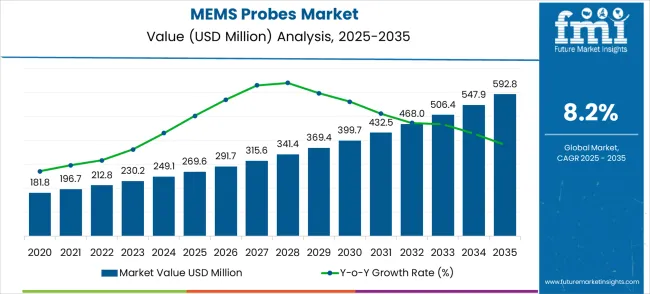
| Metric | Value |
|---|---|
| Estimated Value in (2025E) | USD 269.6 million |
| Forecast Value in (2035F) | USD 592.8 million |
| Forecast CAGR (2025 to 2035) | 8.2% |
Between 2025 and 2030, revenue climbs from USD 269.6 million to USD 399.7 million, producing a larger absolute gain of USD 130.1 million. This period marks a stronger contribution to overall expansion, reflecting wider use of MEMS probes in consumer electronics, automotive electronics, and IoT-enabled devices. The comparison shows that mid-decade growth builds on prior adoption momentum, with rising investments in miniaturization and testing technologies driving broader acceptance. Demand from chipmakers and integrated device manufacturers helps accelerate the market’s trajectory, creating a more robust revenue base.
From 2030 to 2035, the market expands further from USD 399.7 million to USD 592.8 million, representing an absolute gain of USD 193.1 million. This final block delivers the strongest contribution, nearly double the expansion seen in the first period. The 10-year growth comparison indicates that momentum becomes more pronounced in later years as MEMS probes find deeper integration in advanced sensors, biomedical devices, and 5G/6G communication infrastructure. The analysis underscores that while the early stage set the pace, the majority of market gains occur in the second decade, reflecting both scaling effects and broader commercialization across high-growth technology sectors.
Market expansion is being supported by the increasing miniaturization of semiconductor devices and the corresponding demand for more precise and reliable testing solutions. Modern semiconductor manufacturers are increasingly focused on testing technologies that can accommodate shrinking device geometries while maintaining high accuracy and throughput. The proven capability of MEMS probes to provide superior electrical contact, reduced contact resistance, and enhanced durability makes them essential components of advanced semiconductor testing equipment.
The growing emphasis on quality assurance in semiconductor manufacturing and the need for comprehensive device characterization is driving demand for advanced probing technologies that can support complex testing protocols. Industry preference for testing solutions that can handle multiple device types and packaging formats while maintaining consistent performance is creating opportunities for innovative MEMS probe development. The rising influence of artificial intelligence and machine learning applications is also contributing to increased demand for high-performance semiconductors requiring sophisticated testing capabilities across different technology nodes and applications.
The market is segmented by classification, application, and region. By classification, the market is divided into vertical probes, cantilever probes, and others. Based on application, the market is categorized into logic devices, DRAM memory, flash memory, parameter test, and other applications. Regionally, the market is divided into Asia Pacific, North America, Europe, Latin America, and Middle East & Africa.
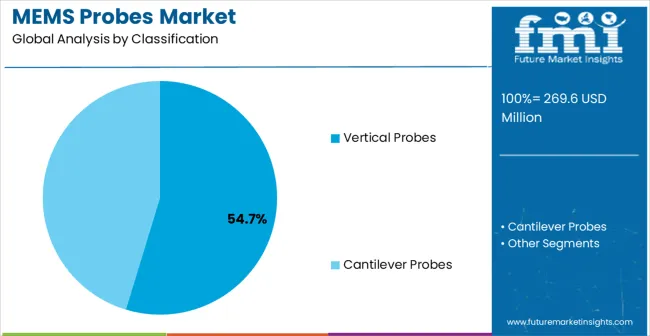
The vertical probes classification is projected to account for 54.7% of the MEMS probes market in 2025, reaffirming its position as the category's dominant technology approach. Semiconductor manufacturers increasingly recognize the superior electrical performance and mechanical reliability of vertical probe architectures for advanced device testing applications. This classification addresses both high-frequency testing requirements and fine-pitch device compatibility, providing optimal solutions for modern semiconductor testing challenges.
This classification forms the foundation of most advanced semiconductor testing systems, as it represents the most technically sophisticated and performance-oriented approach in current probe technology. Research developments and manufacturing innovations continue to strengthen confidence in vertical probe designs. With increasing recognition of the need for precise electrical contact and minimal signal distortion, vertical probes align with both current testing requirements and future technology roadmaps. Their technical superiority across multiple applications ensures sustained market dominance, making them the central growth driver of MEMS probe adoption.
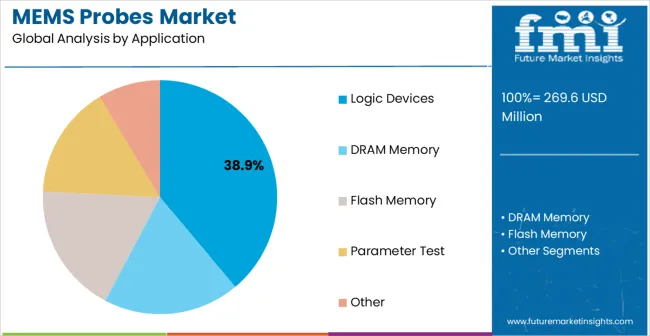
Logic devices are projected to represent 38.9% of MEMS probes demand in 2025, underscoring their role as the primary application driving market development. Semiconductor manufacturers recognize that logic device testing requires the highest precision and most sophisticated probing technologies to ensure proper functionality and performance characteristics. Logic device applications demand exceptional electrical performance and reliability that MEMS probe technologies are uniquely positioned to deliver.
The segment is supported by the continuous advancement of processor technologies requiring increasingly complex testing protocols and the growing deployment of artificial intelligence and high-performance computing applications. Additionally, logic device manufacturing is increasingly adopting advanced testing methodologies that can ensure optimal performance across diverse operating conditions. As understanding of logic device complexity advances, MEMS probe applications will continue to serve as the primary technical driver, reinforcing their essential position within the semiconductor testing market.
The MEMS probes market is advancing steadily due to increasing complexity of semiconductor devices and growing demand for high-precision testing solutions. However, the market faces challenges including high development costs, technical complexity in manufacturing, and requirements for specialized expertise. Innovation in probe design and manufacturing processes continue to influence product development and market expansion patterns.
The growing sophistication of semiconductor fabrication processes is enabling development of more advanced MEMS probe technologies with improved performance characteristics and enhanced reliability. Advanced manufacturing facilities offer comprehensive process control systems, including precise lithography and etching capabilities, that are particularly important for MEMS probe production. Sophisticated testing technologies provide access to comprehensive characterization methods that can optimize probe performance and durability.
Modern probe manufacturers are incorporating advanced materials such as specialized alloys, protective coatings, and high-performance substrates to enhance MEMS probe performance and longevity. These materials improve electrical conductivity, reduce wear characteristics, and provide enhanced stability throughout extended testing cycles. Advanced material integration also enables optimized contact force and improved signal integrity characteristics.
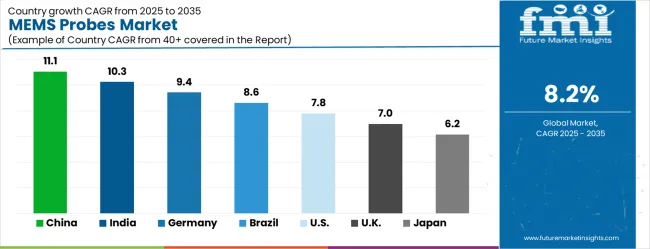
| Country | CAGR (2025-2035) |
|---|---|
| China | 11.1% |
| India | 10.3% |
| Germany | 9.4% |
| Brazil | 8.6% |
| USA | 7.8% |
| UK | 7.0% |
| Japan | 6.2% |
The MEMS probes market is experiencing robust growth globally, with China leading at an 11.1% CAGR through 2035, driven by massive semiconductor manufacturing expansion, government support for domestic chip production, and growing investment in advanced testing equipment. India follows at 10.3%, supported by emerging semiconductor manufacturing capabilities, increasing electronics production, and growing focus on indigenous testing technologies. Germany shows growth at 9.4%, emphasizing precision manufacturing excellence and automotive semiconductor applications. Brazil records 8.6% growth, focusing on expanding electronics manufacturing and industrial automation. The USA shows 7.8% growth, representing mature market dynamics with continued innovation in advanced testing technologies.
The report covers an in-depth analysis of 40+ countries top-performing countries are highlighted below.
China is expected to record strong expansion in MEMS probes at a CAGR of 11.1% through 2035, driven by unprecedented expansion in domestic semiconductor manufacturing capabilities and comprehensive government support for advanced testing equipment adoption. The country's rapidly growing semiconductor ecosystem and increasing capabilities in advanced device production are creating substantial opportunities for sophisticated probe technology deployment. Major domestic and international probe manufacturers are establishing comprehensive research and production facilities to serve the expanding semiconductor testing market.
India is witnessing expansion in MEMS probes at a CAGR of 10.3% through 2035, supported by growing electronics manufacturing sector, increasing semiconductor assembly and test operations, and rising investment in advanced testing capabilities. The country's expanding electronics production base and commitment to domestic manufacturing are driving demand for sophisticated testing solutions. International probe companies and domestic manufacturers are establishing partnerships to serve the growing demand for advanced semiconductor testing equipment.
Revenue from MEMS probes in Germany is projected to grow at a CAGR of 9.4%, supported by the country's leadership in precision manufacturing and comprehensive expertise in advanced testing technologies. German semiconductor equipment manufacturers and automotive companies consistently invest in cutting-edge probe technologies and testing system development. The market is characterized by advanced engineering capabilities, comprehensive industry collaboration, and established relationships between equipment manufacturers and probe technology developers.
The MEMS probes sector in Brazil is anticipated to post a CAGR of 8.6% through 2035, driven by electronics industry expansion, increasing semiconductor assembly operations, and growing focus on advanced manufacturing technologies. Brazilian electronics manufacturers are increasingly adopting sophisticated testing equipment to support quality assurance and performance validation requirements.
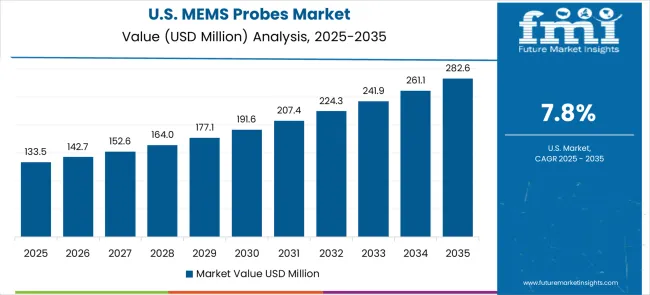
Revenue from MEMS probes in the USA is projected to grow at a CAGR of 7.8%, supported by continuous innovation in semiconductor testing technologies, substantial investment in research and development, and leadership in advanced semiconductor applications. American probe companies and semiconductor manufacturers consistently advance probe technologies through comprehensive research programs and industry collaboration.
MEMS probes in the UK is projected to grow at a CAGR of 7.0% through 2035, supported by technology innovation initiatives and increasing investment in advanced manufacturing capabilities. British technology companies and research institutions emphasize development of next-generation probe solutions within integrated testing frameworks that prioritize performance optimization and reliability enhancement.
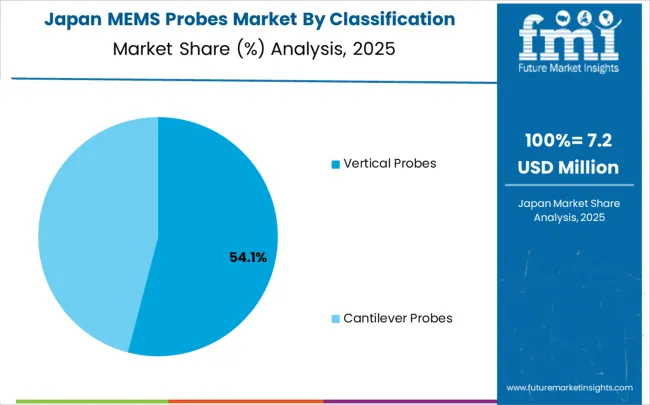
Demand for MEMS probes in Japan is projected to grow at a CAGR of 6.2% through 2035, supported by the country's leadership in precision engineering and comprehensive approach to advanced testing technologies. Japanese probe manufacturers and semiconductor companies emphasize innovation-driven development of sophisticated probe systems within established frameworks that prioritize technical excellence and manufacturing precision.
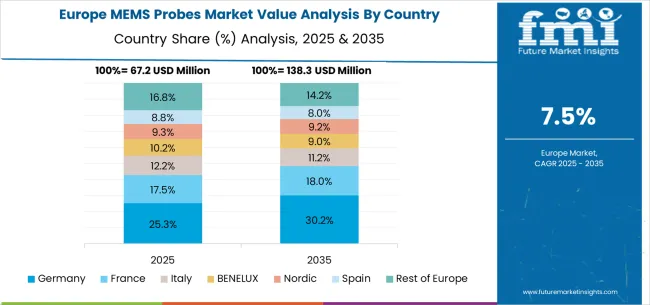
The MEMS probes market in Europe is projected to expand steadily through 2035, supported by increasing adoption of advanced semiconductor testing technologies, rising investment in precision manufacturing, and ongoing innovation in probe system development. Germany will continue to lead the regional market, accounting for 31.2% in 2025 and rising to 32.8% by 2035, supported by strong automotive semiconductor applications, advanced manufacturing capabilities, and comprehensive research and development infrastructure. The United Kingdom follows with 18.4% in 2025, increasing to 19.1% by 2035, driven by technology innovation initiatives, government support for advanced manufacturing, and expanding research collaboration networks.
France holds 15.6% in 2025, edging up to 16.2% by 2035 as semiconductor companies expand testing capabilities and demand grows for advanced probe technologies. Italy contributes 12.3% in 2025, remaining stable at 12.5% by 2035, supported by electronics manufacturing growth and increasing adoption of sophisticated testing equipment. Spain represents 8.7% in 2025, moving upward to 8.9% by 2035, underpinned by expanding electronics production and increasing investment in advanced manufacturing technologies.
Nordic countries together account for 7.4% in 2025, maintaining their position at 7.5% by 2035, supported by advanced technology initiatives and early adoption of innovative testing solutions. The Rest of Europe represents 6.4% in 2025, declining slightly to 3.0% by 2035, as larger markets capture greater investment focus and technology development resources.
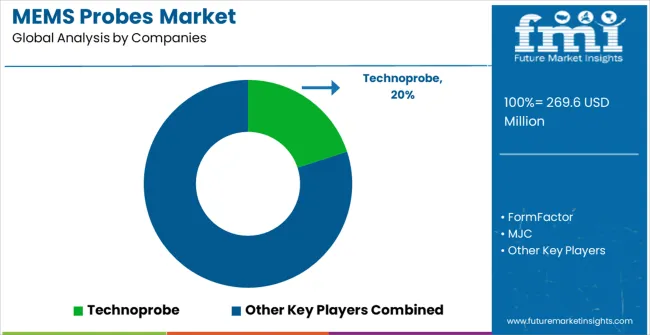
The MEMS probes market is characterized by competition among specialized probe technology companies, established semiconductor equipment manufacturers, and innovative testing solution providers. Companies are investing in advanced materials research, precision manufacturing processes, strategic partnerships, and technology commercialization to deliver high-performance, reliable, and cost-effective probe solutions. Technology development, intellectual property protection, and market positioning strategies are central to strengthening competitive advantages and market presence.
Technoprobe leads the market with significant expertise in advanced probe technology development, offering comprehensive MEMS probe solutions with focus on performance optimization and manufacturing excellence. FormFactor provides established probe card technologies with emphasis on advanced semiconductor testing applications and market leadership. MJC focuses on specialized probe manufacturing and comprehensive technology development programs. MPI Corporation delivers proven testing equipment capabilities with strong focus on probe station integration and system optimization.
Nidec SV Probe operates with focus on precision probe manufacturing and advanced technology scaling capabilities. Will Technology provides comprehensive probe solutions with emphasis on semiconductor testing applications. Cohu leverages extensive semiconductor equipment experience to develop integrated testing solutions. Feinmetall specializes in high-precision probe technologies with focus on advanced packaging applications. LEENO, Yokowo, Yangzhou Yicheng Technology, UIGreen, ZENFOCUS, and Maxone Semiconductor provide diverse technological approaches and market access strategies to enhance overall market development and technology advancement.
| Items | Values |
|---|---|
| Quantitative Units (2025) | USD 269.6 million |
| Classification | Vertical Probes, Cantilever Probes, Other |
| Application | Logic Devices, DRAM Memory, Flash Memory, Parameter Test, Other |
| Regions Covered | Asia Pacific, North America, Europe, Latin America, Middle East & Africa |
| Countries Covered | China, India, Germany, Brazil, United States, United Kingdom, Japan and 40+ countries |
| Key Companies Profiled | Technoprobe, FormFactor, MJC, MPI Corporation, Nidec SV Probe, Will Technology, Cohu, Feinmetall, LEENO, Yokowo, Yangzhou Yicheng Technology, UIGreen, ZENFOCUS, Maxone Semiconductor |
| Additional Attributes | Dollar sales by probe type and application, regional technology adoption trends, competitive landscape, semiconductor industry partnerships, integration with testing equipment, innovations in probe materials and design, manufacturing scalability analysis, and performance optimization strategies |
The global MEMS probes market is estimated to be valued at USD 269.6 million in 2025.
The market size for the MEMS probes market is projected to reach USD 592.8 million by 2035.
The MEMS probes market is expected to grow at a 8.2% CAGR between 2025 and 2035.
The key product types in MEMS probes market are vertical probes and cantilever probes.
In terms of application, logic devices segment to command 38.9% share in the MEMS probes market in 2025.






Our Research Products

The "Full Research Suite" delivers actionable market intel, deep dives on markets or technologies, so clients act faster, cut risk, and unlock growth.

The Leaderboard benchmarks and ranks top vendors, classifying them as Established Leaders, Leading Challengers, or Disruptors & Challengers.

Locates where complements amplify value and substitutes erode it, forecasting net impact by horizon

We deliver granular, decision-grade intel: market sizing, 5-year forecasts, pricing, adoption, usage, revenue, and operational KPIs—plus competitor tracking, regulation, and value chains—across 60 countries broadly.

Spot the shifts before they hit your P&L. We track inflection points, adoption curves, pricing moves, and ecosystem plays to show where demand is heading, why it is changing, and what to do next across high-growth markets and disruptive tech

Real-time reads of user behavior. We track shifting priorities, perceptions of today’s and next-gen services, and provider experience, then pace how fast tech moves from trial to adoption, blending buyer, consumer, and channel inputs with social signals (#WhySwitch, #UX).

Partner with our analyst team to build a custom report designed around your business priorities. From analysing market trends to assessing competitors or crafting bespoke datasets, we tailor insights to your needs.
Supplier Intelligence
Discovery & Profiling
Capacity & Footprint
Performance & Risk
Compliance & Governance
Commercial Readiness
Who Supplies Whom
Scorecards & Shortlists
Playbooks & Docs
Category Intelligence
Definition & Scope
Demand & Use Cases
Cost Drivers
Market Structure
Supply Chain Map
Trade & Policy
Operating Norms
Deliverables
Buyer Intelligence
Account Basics
Spend & Scope
Procurement Model
Vendor Requirements
Terms & Policies
Entry Strategy
Pain Points & Triggers
Outputs
Pricing Analysis
Benchmarks
Trends
Should-Cost
Indexation
Landed Cost
Commercial Terms
Deliverables
Brand Analysis
Positioning & Value Prop
Share & Presence
Customer Evidence
Go-to-Market
Digital & Reputation
Compliance & Trust
KPIs & Gaps
Outputs
Full Research Suite comprises of:
Market outlook & trends analysis
Interviews & case studies
Strategic recommendations
Vendor profiles & capabilities analysis
5-year forecasts
8 regions and 60+ country-level data splits
Market segment data splits
12 months of continuous data updates
DELIVERED AS:
PDF EXCEL ONLINE
MEMS Oscillators Market Size and Share Forecast Outlook 2025 to 2035
MEMS Microphones Market Size and Share Forecast Outlook 2025 to 2035
MEMS Pressure Sensor Market Size and Share Forecast Outlook 2025 to 2035
MEMS Microdisplay Market Analysis - Size and Share Forecast Outlook 2025 to 2035
MEMS Sensor Market - Applications & Growth Forecast 2025 to 2035
MEMS Inkjet Heads Market Growth – Trends and Forecast 2025-2035
Mems Market
Automotive MEMS Market Size and Share Forecast Outlook 2025 to 2035
Automotive MEMS Sensors Market Growth - Trends & Forecast 2025 to 2035
TWS Earbuds MEMS Silicon Microphone Market Size and Share Forecast Outlook 2025 to 2035
Wide Temperature MEMS Oscillator Market Size and Share Forecast Outlook 2025 to 2035
Micro-electromechanical System (MEMS) Market Size and Share Forecast Outlook 2025 to 2035
Single-use Bioprocessing Probes and Sensors Market - Growth & Trends 2024 to 2034

Thank you!
You will receive an email from our Business Development Manager. Please be sure to check your SPAM/JUNK folder too.
Chat With
MaRIA